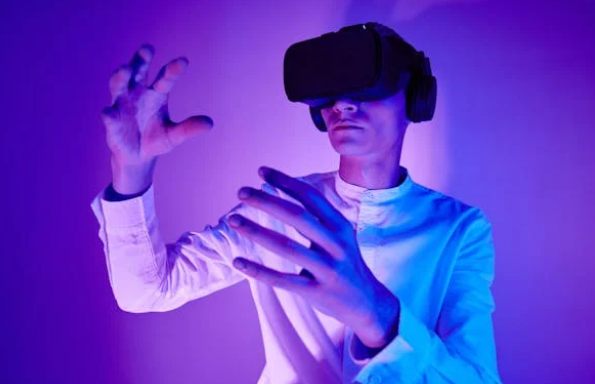
It’s Monday morning in 2025. Instead of navigating through traffic or grabbing a lukewarm coffee on the way to a downtown office, professionals are logging into workspaces that look more like sci-fi movie sets than spreadsheets. Holographic avatars greet each other in digital boardrooms. Team meetings unfold in fully immersive 3D environments. One person might be sitting in Tokyo, another in Lagos, and a third in São Paulo—but they’re all standing in the same virtual room, examining a shared prototype as if it were a physical object.
What once sounded like the stuff of fantasy is increasingly part of the daily routine for a growing share of the global workforce. The future of work isn’t just about remote access or flexible hours anymore. It’s about where and how we work—using tools that blur the boundaries between real and virtual, physical and digital, presence and projection.

From Zoom Fatigue to Full Immersion
Remote work exploded during the early 2020s, largely out of necessity. Platforms like Zoom, Teams, and Slack became the lifelines of office culture. But they also exposed the limitations of flat, screen-based interaction. Eye strain, awkward delays, and that now-iconic phrase—“You’re on mute”—became symbols of a system that, while functional, left much to be desired in terms of human connection.
Enter spatial computing, holography, and mixed reality platforms. These tools offer more than just video calls—they simulate physical presence. Through headsets, smart glasses, or even screen-based projections, workers can “step into” their workplace. Whether it’s brainstorming in a digitally rendered forest or pitching to a client in a virtual gallery, the experience is no longer confined to rectangles.
Companies like Meta, Microsoft, Apple, and dozens of startups are competing to define this new layer of digital life. And while headsets haven’t replaced laptops just yet, the writing is on the wall: two-dimensional workspaces are giving way to something more immersive, more dynamic—and potentially more human.
The Hologram as Colleague
One of the most eye-catching developments is the rise of real-time holographic communication. While not quite the full-body projections from sci-fi films, current systems can already render lifelike avatars that replicate facial expressions, gestures, and even eye contact.
Imagine walking into your living room, flipping a switch, and seeing your manager appear beside your dining table—gesturing to slides, reviewing documents, or just chatting. These holograms aren’t recorded; they’re live feeds, projected in 3D, giving meetings a sense of presence that even high-def video can’t match.
This kind of interaction could dramatically reduce the isolation many feel while working from home. It also challenges assumptions about travel. Why fly across the world for a one-hour meeting when your hologram can do it instantly?
Of course, the tech still has hurdles—cost, accessibility, and social comfort among them. But as hardware shrinks and fidelity improves, it’s likely to become more commonplace, especially in industries that rely on human interaction: education, health, design, and consulting.
Building the Virtual Office
While some companies try to recreate the old office in digital form, others are reimagining it entirely. Virtual offices now span a range of formats—from realistic replications of physical spaces to imaginative realms designed for creativity and play.
A marketing agency might meet in a stylized beach house. A game studio might float on a digital cloud. A financial firm might opt for a sleek, modernist structure hovering in space. The possibilities aren’t just aesthetic; they allow organizations to shape their work environment to fit their values, team dynamics, and brand identity.
These virtual spaces aren’t just for show. They include real functionality: whiteboards, file sharing, breakout rooms, and even spatial audio so you can “hear” someone getting closer or moving away. Coworkers can bump into each other in digital hallways or have impromptu chats near a virtual watercooler.
Crucially, the sense of presence that comes with these environments fosters collaboration in ways that group chats and email threads never could. They make work feel less transactional and more communal—even when everyone is physically alone.

Work-Life Integration, Not Just Balance
As physical offices become optional—or at least less central—the structure of the workday is changing too. People no longer define productivity by hours at a desk. Instead, output, creativity, and flexibility are taking center stage.
This shift is especially pronounced among younger workers, who often prioritize autonomy, wellness, and purpose over hierarchy or tradition. With virtual offices, a worker might check into a morning meeting from their kitchen, take a break for a mid-day hike, then log back in for a client pitch from a beachside coworking pod.
Rather than compartmentalizing life into work and non-work, professionals are designing days that blend the two. It’s not always easy—boundaries can blur and burnout remains a real threat—but the tools are evolving to support this fluid approach.
Some companies are even embedding wellness into the workspace itself: guided meditations in virtual breakrooms, AI coaches that suggest when to unplug, or creative zones designed for mental recharge.
Equity and the New Office Hierarchy
The virtual shift brings fresh questions about equity and inclusion. On one hand, remote access can level the playing field—offering opportunities to those in rural areas, with mobility limitations, or from underrepresented communities.
On the other, access to top-tier hardware and stable internet remains uneven. A holographic team meeting is only effective if everyone has the means to participate. There’s also the challenge of visibility: how do junior employees get mentorship, recognition, or informal feedback if they’re never “seen” in the traditional sense?
Addressing these gaps requires conscious effort. Tech companies and employers alike are exploring ways to make advanced virtual tools more accessible—whether through loaner devices, simplified interfaces, or hybrid models that blend in-person and digital work fairly.
Importantly, the cultural shift must match the technological one. It’s not enough to have a hologram in the room—people must also feel included, respected, and empowered to contribute.
What’s Next?
While the hype around virtual offices and holographic meetings is loud, it’s important to remember that most workplaces still operate in more traditional ways. Not every job can be done remotely, and not every worker wants to strap on a headset. For many, face-to-face interaction remains irreplaceable.
Still, the momentum is undeniable. The tools are evolving rapidly, the appetite for flexibility is strong, and the old office model is no longer the default.
In the years ahead, the most successful organizations may not be those with the flashiest virtual spaces—but those that know how to blend the best of both worlds. That means combining real presence with digital potential, structure with freedom, and tradition with experimentation.
The future of work isn’t just coming—it’s being built, day by day, meeting by meeting, pixel by pixel. Whether it’s through holograms, avatars, or AI-guided workflows, the goal isn’t just to change where we work—but to rethink what work can be.
4o






